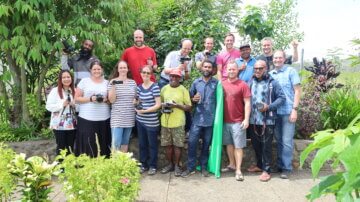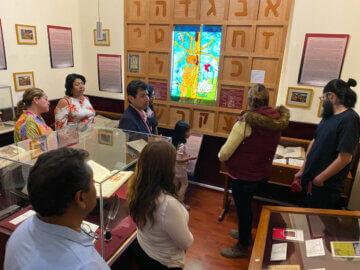Translation and Contextualization
Synopsis:
An important theological issue associated with Bible translation is contextualization*, which concerns the relationship between the Christian faith and various cultures. Contextualization became formally integrated with missiology during the modern missionary movement in the 19th century. It gained prominence in the early 1970s when newer regions of the Church began deconstructing traditional theological contextualization from the West and reconstructing it to suit contexts in the global South and East.
Contextualization can have a variety of interpretations, definitions and applications. It can affect the search for key biblical concepts and terms. Also, any existing older, more antiquated or formal translations can unduly influence attempts at newer or more modernized versions.
Bible translation is an indispensable process in communicating the Bible’s message. The complexities of contextualization make the translation process one of the most difficult aspects of communicating that message. The Bible translator’s role is: 1) to determine what the source text says; 2) to analyze what the source text means; 3) and then to discover how best to express that meaning in the intended language, using cultural, linguistic and theological bridges.
The broad approach toward modern Bible translations generally falls into two categories: 1) the literal, or word-for-word translation; and 2) the dynamic (or functional) equivalence, or idiomatic translation. In the 1950s, Eugene Nida of the United Bible Societies made the ‘dynamic equivalence’ method the standard for the Bible Societies and other Bible translation agencies, including SIL International and Wycliffe.
Theological contextualization raises complex issues regarding the transmission of the message of the Bible into any language and culture. When handled carefully, theological contextualization provides keys for enabling a receptor culture to understand the message of the Bible without excessive foreign influences or doctrinal biases.
* In the field of Bible translation and interpretation, contextualization is the process of assigning meaning as a means of interpreting the environment within which a text or action is executed.
Full Article: Article 5 – Translation and Contextualization
Introduction
This article discusses the important theological issues that are associated with Bible translation. Of particular interest is contextualization (sometimes referred to as inculturation), which is concerned with the relationship between the Christian faith and various cultures. Because it is an essential principle of how God reveals himself in history and through the Scriptures, the topic is as old as Christianity itself. However, it became integrated in a formal sense with missiology during the modern missionary movement by people such as Rufus Anderson (1796-1880) and Henry Venn (1796-1873).
Bible translation is an indispensable process in the communication of the Bible’s message....
Bible translation is an indispensable process in the communication of the Bible’s message, although due to the complexities of contextualization, it turns out to be one of the most difficult aspects of communication. This is because different languages and cultures are involved, each with its own rules and subtleties. The translator must know these and then attempt to express the same message represented in the original Hebrew, Aramaic or Greek texts of the Bible without additions, subtractions or changes in essential content. In addition, translators must not show any bias towards their own doctrinal position.
The shift of the centre of gravity of the Church to the global South and East presents new theological challenges for the Bible translation effort. These are now explored and their implications for the Wycliffe Global Alliance are noted.
Contextualization Issues in Bible Translation
Theological contextualization and translation
The principle of contextualization is well known in theological circles because of how the gospel is encountered within a particular cultural setting. During the colonial era “‘Christianization’ was virtually synonymous with ‘civilization’” (Kim 2009:42). This meant missionaries saw no value in the local culture of indigenous people and consequently viewed their own role as that of uplifting such people from their culture and transplanting them into an imported one that could be a mix of the missionaries’ ‘Christian’ culture and that of the colonial powers. Consequently, expressions recognizing “local feeling were referred to as ‘accommodation’ or ‘adaptation’ in Catholic circles, or ‘indigenization’ among Protestants” (Kim 2009:43).
During the colonial era ‘Christianization’ was virtually synonymous with ‘civilization’.
The concept of contextualization gained prominence in the early 1970s. Voices from the newer regions of the Church began deconstructing traditional theological contextualization from the West and reconstructing it to suit contexts in the global South and East. As a result, although contextualization is a theological concept that is important to mission, it has gained some disrepute as being ‘dangerous’ because of its variety of interpretations, definitions and applications.
A definition of contextualization is important for the underpinning of this chapter. David Hesslegrave says it is “the attempt to communicate the message of the person, works, Word, and will of God in a way that is faithful to God’s revelation, especially as it is put forth in the teachings of Holy Scripture, and … is meaningful to respondents in their respective cultural and existential contexts” (1995:115). Timothy Tennent exegetes this further: “The historic deposit of the gospel is unchanging, but contextualization acknowledges the need to ‘translate’ the message into forms that are meaningful and applicable to people in their separate cultural settings in such a way that the original message and impact of the gospel is communicated” (2011:347).
For Bible translators, there are three features of languages and cultures that influence contextualization: 1) the original biblical texts; 2) the recipient audience; and 3) how the Bible and the faith were transmitted to the translator (Smalley 1995:61).
As a result of contextualization the gospel has been “clothed in multiple languages and has also been coloured by those languages and by the cultures of which they are a part” (Smalley 1995:62). When the Bible is translated into another language and culture, there are unique theological challenges since it was originally authored in the language and cultural contexts of the Hebrews, Greeks and Romans.
Bible translators assume that the sacred text was never meant to be restricted to any one language and culture.
Bible translators assume that the sacred text was never meant to be restricted to any one language and culture. They accept the principle that Jesus spoke Hebrew and Aramaic (and possibly Greek) but he did not restrict his teaching to these languages. Texts such as Matthew 28:18-20, Acts 2:7-11, Revelation 5:7 and 7:9 provide the mandate that Jesus’ words will be communicated through his followers to people of every language, nation and ethnic group.
This means the Bible translator’s role is complex: 1) to determine what the source text says; 2) to analyze what the source text means; 3) and then to discover how best to express that meaning in the intended language. In order to do this well, Bible translators need to discover how best to communicate God’s message using cultural, linguistic and theological bridges.
Examples of challenging Bible translation issues
Paul Pierson suggests that when Bible translators are working in a language that has not been translated before, in their search for a term for God, they have at least three choices: 1) “use an indigenous term, which may have so many pagan connotations that it cannot be transferred”; 2) Introduce a “foreign term” from elsewhere (such as from a predominant language); or 3) “borrow a term from a neighboring language... but which does not hold the problematic connotations of an indigenous term” (2008:171).
Kwame Bediako states that in the context of West Africa most Bible translators discovered that the god who had been revered in indigenous languages “was found to be the God of the Bible in a way that none of the major European gods, whether Zeus, Jupiter or Odin, could be” (2001:4). For example, when the creator was ‘Ngai’, who had been known for generations in African pre-Christian tradition and was equivalent to the Christians’ God, the result was support for a vernacular indigenous Christian theology adapted for the local situation (Bediako 2001:4). Lamin Sanneh notes in Nigeria how the use of ‘Olorun’, the Yoruba high god, was successfully introduced as the Christian God (2003:11).
This raises the question about who are the legitimate ‘gatekeepers’ of Biblical texts.
Recognizing the contribution of African theologians to African Bible translation is overdue and is now taking place due to the growth of the African church. Up until recently most translations done in Africa were influenced by Westerners. This raises the question about who are the legitimate ‘gatekeepers’ of Biblical texts. The Western church commonly assumes this is their right to do so which motivates it to speak ‘above’ Christians from other regions. This makes the Western voice intimidating to the rest of the world. However, space must be created for the African voice in matters of African Bible translation. As Stephen Coertze states, “African theologian[s] will bring a new set of hermeneutical principles and theology to the Bible translation table” (2008:13). Accordingly the impact of African theologians and the African church on Bible translation will help determine that the Western church is “no longer controlling or dictating what it perceives catholic truth to be. It will no longer determine the standards of the Bible translation process or the quality of the final product” (Coertze 2008:14).
Throughout the history of vernacular versions of the Bible, translators have adopted local idioms and concepts for the basic doctrines of the Christian faith. This is often a very critical and difficult issue. Note what happened in Korea: Prior to any serious evangelistic effort, missionaries worked on the translation of the Bible for the ‘hermit kingdom’ (a self-reference, due to its preference to be isolated). As a Bible translator, John Ross (1842-1915) made the critical decision to use the Korean term ‘Hananim’ for God (which meant ‘ruler of heaven’). Ross wanted wherever possible to use Korean terms rather than borrowed or imported ones. Consequently the Korean Bible was quickly accepted and became “one of the most important contributions to Korean Protestantism” (Hong 2008:79). Pierson elaborates that many Korean theologians believe “that one reason for the success of Protestant churches in Korea is that they chose the right name for God” (2008:170).
In the Thai Buddhist context the biblical concept of a strong God is difficult to portray.
Each culture must be studied carefully before deciding on key biblical concepts and terms. For example, in the Thai Buddhist context the biblical concept of a strong God is difficult to portray. This is because the word for God is weak in Thai, because deity is portrayed as being weak in Buddhism. Working in this context, William Smalley states that one “cannot translate into Thai without Buddhist terminology, which then gives the Christian message a Buddhist cast different from the Jewish and Greco-Roman cast of the original” (1995:62). Therefore, even though the Bible is “coloured by the Buddhist medium, it also challenges the medium because the Bible reverberates with the story of a strong God, and if that story is translated powerfully, it partially changes the colouring for those who hear” (Smalley 1995:62). However, the biblical teaching of God being love is acceptable to the Thai Buddhist. The biblical text describes God as dynamic because he saves, protects and loves people. His son Jesus died for people and identified with their difficulties and suffering. Smalley describes this as “new fruit grafted on Buddhist cultural roots” (1995:12).
There are many other considerations in translating the Bible so that it is acceptable and meaningful in another culture. A problematic issue for Bible translation for Muslim audiences has been whether to use Allah as the term for God. Even though Arab Christians used the Arabic Allah before Mohammed did in the Koran, it has become a missiological issue of concern to some and is without a straightforward answer. Pierson elaborates:
Where did the Greek New Testament get its word for God? Right out of Greek paganism! Theos. It is not a specifically Christian term. Where did the Old Testament get its names for God? Elohim. Yahweh probably was new with the Hebrews, but Elohim and Adonai were not. They were used in the surrounding religions. My point is that in both the Old and New Testaments, as well as throughout history, the People of God have adopted the names for God used in the surrounding cultures, but then poured new meaning into them. Whatever name we use for God, we believe that God has ultimately defined himself for us in the Incarnation, in Jesus Christ. (2008:170)
Effects of Bible translation on an audience’s understanding of the text
An older, more antiquated or very formal translation will unduly influence attempts at newer or more modernized translations. Translators who attempt to produce an updated or contemporary translation may find that the previous translation has created a limit on what the audience will accept with any new translation. This often means it will get rejected or not be endorsed by church hierarchy. One only has to look at modern twenty-first century English translations that have not been accepted due to the status of the Elizabethan English of the King James Bible.
Modern Bible translations generally fall into two categories. The first is known as a ‘literal translation’. The emphasis is on faithfulness to the “sentence structure, verbal nuances, and idioms of the original languages in order to assure accuracy in emphasis and style” (Wegner 1999:400). This is sometimes called a ‘word-for-word’ translation and has been claimed as the standard for English translations such as the King James Bible (KJB), New American Standard Bible (NASB), Revised Standard Version (RSV), New Revised Standard Version (NRSV) and the English Standard Version (ESV).
The second category is called the ‘dynamic’ or ‘functional equivalence’ Bible translation. Here the focus is on “the style, structure and idioms of the new language” (Wegner 1999:400) and the translated text often uses idioms to most closely represent the original meaning of the Hebrew or Greek. This category is also sometimes called an ‘idiomatic’ translation and is represented in English translations such as the New International Version (NIV), Good News Bible (GNB), New Living Translation (NLT), Contemporary English Version (CEV) as well as paraphrases like The Message (MSG).
It was Eugene Nida of the United Bible Societies in the 1950s, who made the dynamic equivalence method the standard one used by the Bible Societies and other Bible translation agencies, including SIL International and the Wycliffe Global Alliance (all of which are part of the Forum of Bible Agencies International).
According to Smalley (1995:64-5) there are a number of assumptions underlying the dynamic equivalence model: 1) the translator has a well-informed (by using the best biblical and translation resources available) understanding of the meaning of the text; 2) the meaning will always be expressed “in clear natural equivalents”; 3) the translated text will be understood and accessible to people at all levels of society; 4) despite variations in the source text structure it will none the less be communicated so that it will be understood as a whole; 5) cultural behaviour described in the Bible is subject to some degree of misinterpretation because it expresses a different meaning to the recipient audience; and 6) the meaning is more important than the form, which is a necessary principle in order to avoid literalism.
Conclusion
Theological contextualization raises complex issues regarding the transmission of the message of the Bible into any language and culture. It follows that it is essential to understand the context of other cultures, including their worldview, social-economic structures, and other factors. When handled carefully, theological contextualization provides keys for enabling a receptor culture to understand the message of the Bible without excessive foreign influences or doctrinal biases.
The latest
View all articles
03/2024 Pacific: Papua New Guinea
Informing, teaching, inspiring: PNG workshop teaches video storytelling for language communities
PNG workshop teaches video storytelling for language communities
Read more
02/2024 Global
Looking ahead at 2024
As the year unfolds, we marvel at the work of God in our rapidly changing world. And, we look forward to a number of gatherings and conversations intended to draw us together.
Read more
01/2024 Americas
Telling the Bible's Story
It may come as a surprise that a museum is among the Wycliffe Global Alliance organisations.
Read more